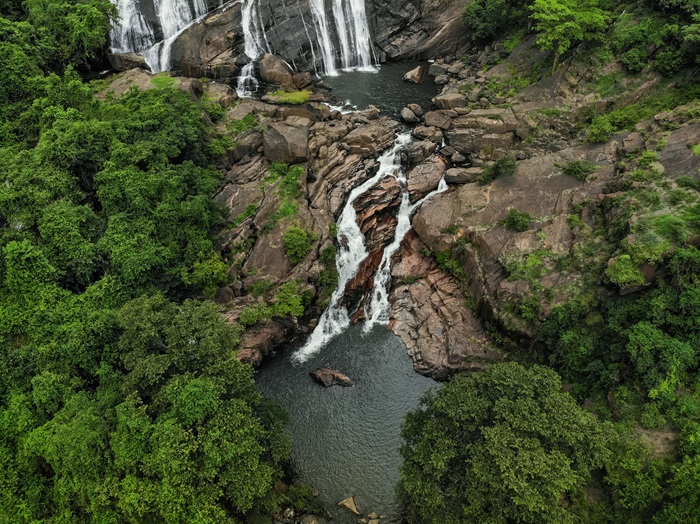
Nature is life. Nature is interconnected, intertwined, and indivisible with human life, our societies, and economies. Yet, the world over, land, seas, air, freshwater and wildlife are being destroyed at an alarming rate.
According to the United Nations Development Programme (UNDP) on average, wildlife populations have declined almost 70% since 1970. Wild mammals have declined as a share of the global mammal biomass to just 4% as at 2015.[1]
Around 60% of global GDP is at least moderately dependent on natural resources, yet resource extraction and processing cause over 90% of global biodiversity loss.[2] The world is currently witnessing the dual crisis of catastrophic nature loss and climate change—a massive transgression on two key planetary boundaries.
Sri Lanka is a perfect example of a paradise at the nexus of climate change and biodiversity loss. Sri Lanka is one of the most climate-vulnerable countries in the world, ranking within the top ten countries, consecutively over the recent years.[3] On average, Sri Lanka experiences US$313 million in annual disaster losses, due to acute climate-vulnerability.[4] Sri Lanka’s unique biological diversity is facing general decline, as well. 27% of 240 identified species of birds are threatened, along with 66% of amphibian species, 56% of mammals, 49% of freshwater fish species and 59% of reptiles. In particular, one of Sri Lanka’s well-known and flagship species, the elephant, has been affected by a population decline. As for flowering plants, 1,385 species of the 3,154 identified species are classified as threatened, the high majority of which (594) are endemic to Sri Lanka.[5] From 2001 to 2023, Sri Lanka lost 222 kha of tree cover, equivalent to a 5.6% decrease in tree cover since 2000.[6]
The world over, resources have been gradually shrinking, and Sri Lanka is no stranger to this, especially given the cascading impacts of the economic crisis. A Finance Needs Assessment conducted in 2018 by the Biodiversity Financing Initiative (BIOFIN) found that Sri Lanka would need approximately 31 billion LKR (190 million USD) within 2018-2024 period with the caveat that the government will maintain its current level of investments for the period. The Climate Prosperity Plan submitted to the UNFCCC as the country’s long-term low GHG emission strategy requires US$ 26 billion, US$ 6.5 billion per year if we are to successfully mitigate and adapt to climate change—a startling reckoning for the country on both fronts.
It is in this context that we mark 2024’s International Day for Biological Diversity. This year, the day serves as a call to action: ‘Be Part of the Plan. ’Given the current state of affairs, it is evident that there is an imminent need to forward catalytic actions towards halting and reversing biodiversity loss, and to accelerate the mobilization of resources towards countries, those like Sri Lanka, to reach their biodiversity targets and commitments.
There is a need for more bold, more imaginative, and more ambitious solutions. For instance, the BIOFIN initiative—a UNDP managed global collaborative partnership—works towards improving biodiversity outcomes using finance and economics to bridge the financing gap by mobilizing innovative financing for investments in biodiversity. The National Sustainable Tourism Certification Scheme, one of BIOFIN’s 16 financial solutions for Sri Lanka, has been the catalyser in mobilizing more than 500 million LKR from various stakeholders for investments in sustainable tourism, —a clear example of innovation paying it forward! With renewed ambition, UNDP’s Nature Pledge commits to provide accelerated and upscaled support to over 140 countries to reach their ambitious targets in the historic Global Biodiversity Framework. Another example was BIOFIN’s support to the Central Bank of Sri Lanka to initiate the Sustainable Finance Roadmap which paved the way to promoting sustainable financing among commercial banks in the country.
All these innovative steps in the right direction will lead to sustainable management of services provided by ecosystems and biodiversity which will ultimately lead to conserve and promote human well-being, enhance ecosystem services, and create sustainable livelihoods for Sri Lanka’s people.
Each one of us has a role to play in conserving biodiversity, whether by adopting sustainable practices in our daily lives, supporting conservation initiatives, or advocating for policies that prioritize nature conservation. By working together, we can ensure a sustainable future where biodiversity thrives, enriching and sustaining life for generations to come—Be Part of the Plan!
